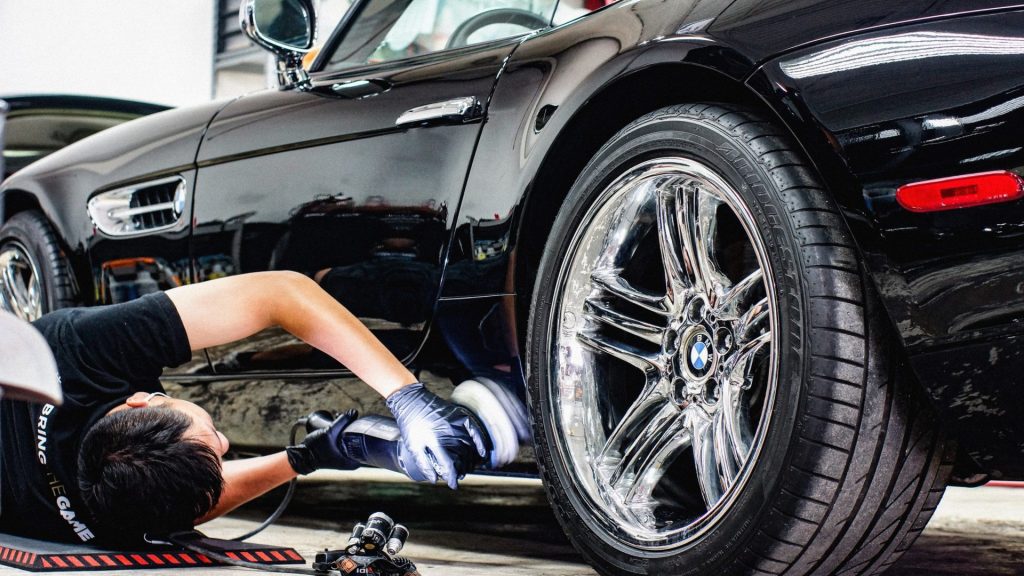Your vehicle’s paint is its first impression and the way it looks will make or break your resale value. Paint correction removes swirl marks, scuffs and scratching by bird droppings, acid rain etching, and other surface imperfections.
It can also be used to reduce oxidization and revitalize your paint. Ceramic coatings can then be added to “lock-in” that perfection for easy washing, superior gloss, and enhanced protection.
What is Paint Correction?
Essentially, paint correction is buffing your car’s finish to fix swirl marks, scuffs, and scratches. A professional detailer will use a combination of different size polishers and pads with varying degrees of intensity to correct your vehicle’s paintwork. This process is similar to how you would sand wood to repair surface damage. The more serious the damages, the more stages a technician will need to perform in order to fully correct your vehicle’s paintwork.
The first step in any good detailer’s process is to decontaminate the vehicle. This can be done with a quick detailing spray such as Americana Global Release Iron and Fallout Remover, or a clay bar. This process ensures that there is no dirt, sap, or contaminants stuck in the clear coat prior to performing any sort of work on the car. This will prevent any unnecessary damage and allow for the best results to be achieved. Once the car is properly decontaminated, your detailer will begin the corrective work by using a compound and polish to remove any major imperfections.
How Does Paint Correction Work?
There is nothing quite like the look of a pristine vehicle. It evokes a sense of pride and ownership as you drive it around town, and it can help boost your car’s resale value if you ever plan to sell it. However, a car can lose its luster due to dirt, swirl marks, scratches, bird droppings, tree sap gloss reduction, and oxidation over time.
Paint correction helps eliminate these imperfections and restores a car’s showroom shine. It is sometimes referred to as buffing, cutting and polishing, or even just “polishing.” It is important that a decontamination process is completed before the polishing begins. This helps ensure that the protection you’re going to apply afterwards – such as a ceramic coating or wax – will bond correctly to the surface of your paint.
The level of damage and the severity of the scratches will determine how many stages are needed to correct your vehicle’s paint. Light scratches may only require one stage whereas deeper scratches would likely need multiple sanding steps, each getting progressively lighter and softer.
What Can I Expect from Paint Correction?
Paint correction is a labor intensive process that uses professional polishing machines and cutting compounds to remove minor surface defects such as light swirls, scratches and water etching. When done correctly, it can result in the kind of flawless finish that would be the envy of even a Concours entrant.
The biggest question when considering paint correction is whether you are willing to commit the time and money to maintaining the results. A good detailer will recommend a ceramic coating or nano wax after a correction to lock in that new-car look as long as possible.
If you want your car to look its best, you will have to commit to keeping it clean and protected from things like bird droppings that contain acids that can eat away at the clear coat. That means washing regularly and using safe techniques. It also means removing any scuffs as soon as you see them so they don’t become more serious and require another round of paint correction.
How Much Does Paint Correction Cost?
There are many factors that affect how much paint correction costs. These include location, size of vehicle, and the level of work to be done. Many car detailing experts have a flat rate for certain processes, while others charge hourly. It is always wise to set a budget before getting a paint correction service.
It is a time-consuming and labor-intensive process to remove swirl marks, scratches, oxidation, water spots, and other blemishes from a vehicle’s exterior. This is usually done by a detailer using a dual-action polisher and various pads, compounds, and polishes.
The result is a flawless finish that will make your car look like it did when you first bought it. A good paint job can last up to five years or more, as long as it is properly maintained with regular washing and waxing. Ceramic coating is also a popular option after paint correction, as it will protect your car from contaminants, UV rays, and weather.paint correction near me



